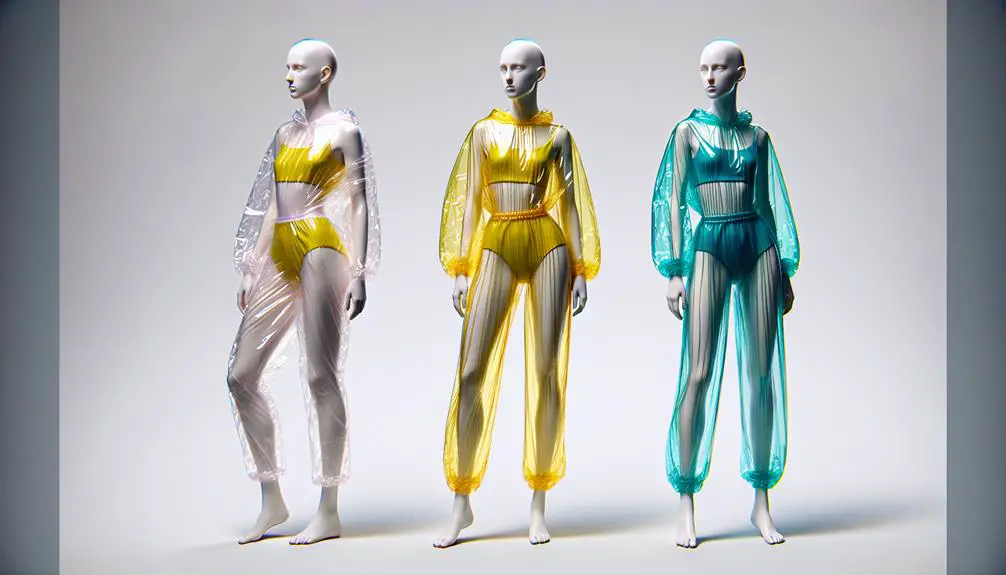Wearing polyester feels like wearing plastic because polyester, a synthetic fabric, is made from petrochemicals, closely resembling plastic in composition. It's important to understand this connection before choosing polyester clothing. The process of making polyester involves chemicals and high energy use, impacting both the environment and potentially our health. Considering these factors can guide us toward more informed clothing choices.
Table of Contents
Key Takeaways
- Polyester is essentially plastic-based, derived from petroleum like plastic.
- Wearing polyester clothing can release microplastic fibers, similar to plastic shedding.
- Polyester shares the synthetic nature and environmental concerns associated with plastics.
- Polyester fibers, like plastic, can contribute to microplastic pollution.
- Understanding polyester's plastic origins can influence clothing choices for sustainability.
Understanding Polyester Composition
In crafting polyester, synthetic fibers are skillfully composed from PET, a thermoplastic polyester, through a chemical process called polymerization. These fibers are fundamentally long chains of repeating molecular units, giving polyester its strength and durability.
It's fascinating how plastic bottles can be recycled and transformed into polyester fibers, showing the versatility of this material. The composition of polyester allows it to be used in a wide range of applications, from clothing and home textiles to industrial purposes.
The ability to manipulate the composition of polyester fibers during the manufacturing process enables producers to create fabrics with specific properties like moisture-wicking, stretch, or warmth retention. Understanding the plastic origins of polyester sheds light on its synthetic nature and helps us appreciate the innovation behind turning plastic waste into a valuable textile material.
Polyester Production Process Explained
Moving from understanding the composition of polyester to exploring its production process, polyester is crafted through a meticulous series of steps that transform synthetic fibers into versatile textile materials. Polyester production begins with raw materials derived from petroleum, such as ethylene glycol and terephthalic acid. These compounds undergo polymerization to form PET, a type of thermoplastic polyester.
The polymerization process creates long chains of repeating units that are then extruded and spun into thin filaments. These filaments are further processed to create polyester fibers, which can be woven into various fabrics. The synthetic nature of polyester gives it a plastic-like quality, making it durable and resistant to wrinkles and shrinking.
Understanding the detailed production process of polyester sheds light on its composition and properties, highlighting its unique characteristics as a widely used textile material.
Environmental Impacts of Polyester
Polyester's production and usage have a significant impact on the environment due to its contribution to microplastic pollution in oceans and the release of synthetic microfibers during washing. The synthetic nature of polyester makes it non-biodegradable, leading to persistent environmental pollution. These aspects, combined with the fact that polyester resembles plastic in its composition, have serious consequences for ecosystems and marine life. Moreover, global textile production emits a staggering 1.2 billion tons of CO2 annually, with polyester being a significant contributor to this carbon footprint. Below is a table that highlights key environmental impacts of polyester:
| Environmental Impact | Description |
|---|---|
| Microplastic Pollution | Polyester sheds fibers, contributing to microplastic pollution in oceans. |
| Synthetic Fibers Release | Washing polyester clothing releases synthetic microfibers into water sources. |
| Non-Biodegradable Nature | Polyester's non-biodegradable characteristics lead to persistent environmental pollution. |
Recycled Polyester Sustainability Analysis
Recycled polyester offers a promising solution for reducing waste and lessening environmental impact. Eco-friendly production methods, such as diverting plastic bottles from landfills, contribute to a more sustainable textile industry.
Additionally, exploring end-of-life recycling options can further enhance the lifecycle of polyester products.
Eco-Friendly Production Methods
Opting for recycled polyester in clothing production offers a more sustainable approach by diverting waste like plastic bottles from landfills. This method requires up to 59% less energy and produces up to 32% fewer greenhouse gas emissions compared to virgin polyester.
However, challenges such as water consumption during production and limited recycling infrastructure in many countries exist. Quality concerns also arise as recycled polyester may be less strong or durable than virgin polyester.
Both mechanical and chemical recycling processes are utilized, but it's crucial to emphasize that the quality and performance of recycled polyester can degrade with each cycle.
Despite these challenges, the eco-friendly production methods associated with recycled polyester contribute significantly to reducing environmental impact.
Reduced Environmental Impact
Choosing recycled polyester over virgin polyester presents a more sustainable option for reducing environmental impact by repurposing waste materials like plastic bottles. When considering recycled polyester, it's essential to evaluate the following aspects:
- Reduced Energy Consumption: Using recycled polyester can require up to 59% less energy than producing virgin polyester.
- Lower Greenhouse Gas Emissions: Recycled polyester production can result in up to 32% fewer greenhouse gas emissions compared to virgin polyester.
- Sustainable Resource Usage: Recycled polyester is considered more sustainable as it requires fewer resources in its production process.
These factors highlight the environmental benefits of opting for recycled polyester, emphasizing its role in promoting a more eco-conscious approach to textile production.
End-Of-Life Recycling Options
Amid considerations for sustainable textile practices, the end-of-life recycling options for polyester demand critical evaluation. Recycled polyester offers the benefit of diverting waste materials like plastic bottles from landfills, thereby reducing environmental impact compared to virgin polyester.
However, the production of recycled polyester still entails significant water consumption. Mechanical and chemical recycling processes are employed to recycle polyester, but quality and performance may degrade with each recycling cycle. While using recycled polyester can lead to up to 59% less energy consumption and 32% fewer greenhouse gas emissions than virgin polyester, there are concerns regarding its strength and durability.
These factors highlight the importance of carefully weighing the environmental benefits against potential drawbacks when considering end-of-life recycling options for polyester in the context of sustainable practices.
Challenges With Recycled Polyester
Why do challenges persist with recycled polyester despite its sustainability benefits?
- Quality Concerns: Recycled polyester may exhibit lower quality compared to virgin polyester, leading to issues like reduced strength and durability.
- Water Consumption: Despite being a more eco-friendly option, the production of recycled polyester still requires significant water usage, impacting its overall sustainability.
- Recycling Infrastructure Limitations: The effectiveness of recycled polyester as a sustainable choice is hindered by the lack of adequate recycling infrastructure in many regions, limiting its widespread adoption.
These challenges highlight the complexities associated with recycled polyester. Issues such as quality variations, environmental impacts like water consumption, and the need for improved recycling facilities all contribute to the ongoing difficulties in fully embracing recycled polyester as a solution.
Additionally, the processes of mechanical and chemical recycling, while valuable, can lead to performance degradation over successive recycling cycles, posing further obstacles to the widespread and long-term use of recycled polyester in the fashion industry.
Recyclability of Recycled Polyester
Recycled polyester offers a sustainable alternative to virgin polyester by diverting waste materials like plastic bottles from landfills. The production of recycled polyester consumes up to 59% less energy than virgin polyester, contributing to a reduction in greenhouse gas emissions by up to 32%.
Mechanical and chemical recycling processes are employed to recycle polyester, each with its own benefits and challenges. While mechanical recycling involves melting down plastic bottles to create new polyester fibers, chemical recycling breaks down the polymers into monomers for repolymerization.
However, it's essential to note that the quality and performance of recycled polyester may deteriorate with each recycling cycle. Therefore, sustainable practices such as promoting durability and longevity in clothing design can help mitigate the impact of decreased quality in recycled polyester garments.
Understanding the various recycling methods and their implications is essential for making informed decisions regarding the use of recycled polyester in the fashion industry.
Considerations Before Buying Polyester Clothing
When purchasing polyester clothing, it's important to take into account its synthetic composition and the environmental and health implications it presents.
- Synthetic Nature: Polyester is derived from petroleum-based materials, making it essentially plastic in the form of fibers.
- Environmental Impact: The production process of polyester involves high energy consumption and chemical treatments, similar to plastic manufacturing, contributing to environmental degradation.
- Health Risks: Wearing polyester can lead to potential health risks as it sheds microplastic fibers, which can enter the food chain and pose health hazards.
Before buying polyester clothing, it's vital to consider these factors. Being aware of its synthetic nature, the environmental impact of its production processes, and the health risks associated with wearing polyester can help individuals make more informed decisions when selecting clothing items.
Polyester Vs. Plastic: a Comparison
In comparing polyester and plastic, it becomes evident that while polyester is a textile made from synthetic fibers, plastic encompasses a wider range of synthetic materials. Polyester, derived from PET, a type of thermoplastic polyester also used in plastic bottles, undergoes a polymerization process to form fibers.
Both polyester and plastic originate from petroleum-based raw materials, but polyester is tailored for textile applications. Despite feeling akin to plastic due to its synthetic nature, polyester is designed with specific properties for clothing. Its durability and versatile characteristics make it a prevalent material in the fashion industry, balancing between plastic-like attributes and functional textile qualities.
While plastic includes a broader spectrum of synthetic substances, polyester's focus on synthetic fibers distinguishes it as a specific type within the plastic family, primarily known for its role in textiles.
Sustainable Fashion Alternatives to Polyester
To embrace sustainable fashion, one can explore alternatives to polyester such as organic cotton, hemp, and linen. When looking for sustainable fashion options, consider the following:
- Opt for organic cotton: Organic cotton is grown without harmful pesticides and chemicals, making it a more environmentally friendly choice compared to conventional cotton.
- Choose recycled polyester: Look for garments made from recycled polyester (rPET) to reduce waste and minimize the use of new resources, contributing to a circular fashion economy.
- Support transparent and eco-friendly brands: Prioritize brands that offer transparency in their supply chain and production processes, ensuring ethically sourced materials and sustainable practices are in place.
Frequently Asked Questions
Is Polyester Similar to Plastic?
Polyester is akin to plastic due to its synthetic nature and composition. It is fundamentally plastic in textile form, made from PET fibers derived from petroleum. The molecular structure of polyester closely resembles plastic bottles.
What Does Polyester Feel Like to Wear?
Wearing polyester can feel smooth and slick, lacking breathability in hot conditions. It's durable, resistant to wrinkles, and easy to care for, but may not offer the same softness as natural fibers.
Is Polyester Unhealthy to Wear?
Wearing polyester may pose health risks due to its lack of breathability and synthetic nature. The potential for skin irritation and discomfort exists, emphasizing the importance of considering personal comfort and safety when choosing clothing materials.
Is Polyester Uncomfortable to Wear?
Wearing polyester can be uncomfortable due to its lack of breathability, causing sweating and skin irritation. The synthetic fibers trap moisture, making me feel hot and sticky. Allergies may worsen, and the plastic-like feel can be unpleasant.
- The Use of Nonwovens in Construction and Civil Engineering - July 11, 2025
- The Use of Nonwovens in Construction and Civil Engineering - July 11, 2025
- The Use of Nonwovens in Construction and Civil Engineering - July 11, 2025






